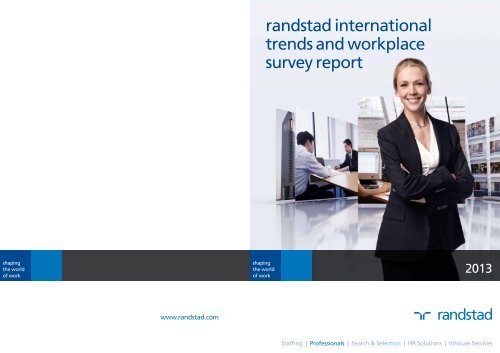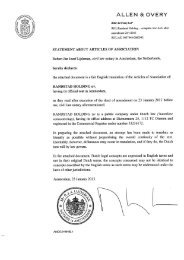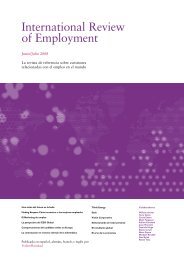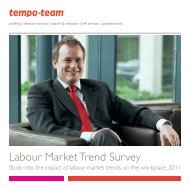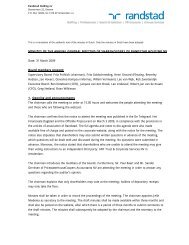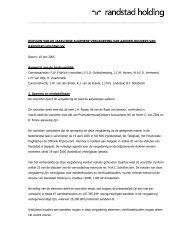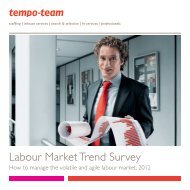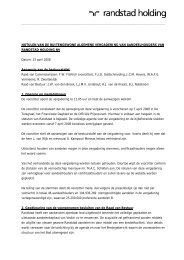randstad international trends and workplace survey report
randstad international trends and workplace survey report
randstad international trends and workplace survey report
You also want an ePaper? Increase the reach of your titles
YUMPU automatically turns print PDFs into web optimized ePapers that Google loves.
www.<strong>r<strong>and</strong>stad</strong>.com<br />
<strong>r<strong>and</strong>stad</strong> <strong>international</strong><br />
<strong>trends</strong> <strong>and</strong> <strong>workplace</strong><br />
<strong>survey</strong> <strong>report</strong><br />
2013
preface<br />
Although the content of this<br />
publication has been composed<br />
with the outmost care, the<br />
publisher cannot be held responsible<br />
for any errors <strong>and</strong> omissions<br />
which may occur.<br />
No rights may be derived from<br />
this document.<br />
This <strong>survey</strong> has been conducted<br />
by ICMA Group, Waterloo<br />
Belgium.<br />
Welcome to the annual R<strong>and</strong>stad <strong>international</strong> <strong>trends</strong> <strong>and</strong> <strong>workplace</strong> <strong>survey</strong>. We are<br />
pleased to present the 2013 issue. This <strong>report</strong> offers insights into various <strong>trends</strong> <strong>and</strong><br />
developments impacting your business, collected from companies operating within<br />
various industries, as well as salary statistics for all the different markets <strong>and</strong> geographic<br />
regions in which they operate.<br />
From October to December 2012 our consultants interviewed 1,001 key decision<br />
makers <strong>and</strong> human resources executives across 8 countries. The <strong>report</strong> explores subjects<br />
related to the economy, talent <strong>and</strong> recruiting, sustainability, <strong>trends</strong> & innovation in the<br />
<strong>workplace</strong>, compensation <strong>and</strong> benefits, etc. The employment market is continuously<br />
changing, not in the least brought on by the volatility of the economic environment.<br />
While companies have focused on emphasizing their core competencies, they are also<br />
planning for the future, in order to remain competitive <strong>and</strong> successful, <strong>and</strong> grasp opportunities<br />
for growth if <strong>and</strong> when they arise. This year’s <strong>survey</strong> discusses these developments<br />
as well as many others. An executive summary highlights our key findings on<br />
page 6.<br />
At R<strong>and</strong>stad we remain focused on providing the quality talent our clients need to<br />
impact their organization’s bottom line <strong>and</strong> its future success. In our business, relationships<br />
are key, <strong>and</strong> we extend a sincere thank you to everyone who participated in this<br />
year’s <strong>survey</strong>.<br />
Ben Noteboom<br />
CEO R<strong>and</strong>stad Holding<br />
<strong>r<strong>and</strong>stad</strong><br />
<strong>international</strong><br />
<strong>trends</strong> <strong>and</strong><br />
<strong>workplace</strong><br />
<strong>survey</strong> <strong>report</strong><br />
2<br />
R<strong>and</strong>stad <strong>international</strong> <strong>trends</strong> <strong>and</strong> <strong>workplace</strong> <strong>survey</strong> <strong>report</strong> 2013 R<strong>and</strong>stad <strong>international</strong> <strong>trends</strong> <strong>and</strong> <strong>workplace</strong> <strong>survey</strong> <strong>report</strong> 2013<br />
3<br />
2013
contents<br />
1 Structure of the <strong>report</strong> 5<br />
2 Key findings 6<br />
3 Company 10<br />
4 Participant profile 12<br />
5 HR <strong>and</strong> challenges 14<br />
6 Employment <strong>and</strong> recruitment strategies 16<br />
7 Trends <strong>and</strong> innovation in the <strong>workplace</strong> 19<br />
8 Economic impact <strong>and</strong> outlook 22<br />
structure of<br />
the <strong>report</strong><br />
In this <strong>report</strong> you will find:<br />
Key findings<br />
Overview of the main findings.<br />
Company<br />
Detailed information on the companies that have participated in the <strong>survey</strong>.<br />
Participant profile<br />
Detailed information on the participants, i.e. the decision makers <strong>and</strong><br />
HR executives.<br />
HR <strong>and</strong> challenges<br />
Current <strong>and</strong> future challenges that are or will be affecting HR <strong>and</strong> organizations<br />
in the future as well as an outline on how companies deal with skill<br />
shortages <strong>and</strong> the type of benefits they offer to their employees.<br />
Employment <strong>and</strong> recruitment strategies<br />
Perspectives on the sources <strong>and</strong> processes used to recruit <strong>and</strong> assess talent,<br />
explanations on whether companies are willing to hire temporary or<br />
permanent staff <strong>and</strong> reasons why organizations might fail to attract<br />
top talent.<br />
Trends <strong>and</strong> innovation in the <strong>workplace</strong><br />
Important changes <strong>and</strong> new ways of working in the <strong>workplace</strong> <strong>and</strong> recruitment<br />
processes.<br />
Economic impact <strong>and</strong> outlook<br />
How does the current economic situation impact the organizations’<br />
initiatives <strong>and</strong> future perspectives.<br />
4 R<strong>and</strong>stad <strong>international</strong> <strong>trends</strong> <strong>and</strong> <strong>workplace</strong> <strong>survey</strong> <strong>report</strong> 2013 R<strong>and</strong>stad <strong>international</strong> <strong>trends</strong> <strong>and</strong> <strong>workplace</strong> <strong>survey</strong> <strong>report</strong> 2013<br />
5<br />
1<br />
<strong>r<strong>and</strong>stad</strong><br />
<strong>international</strong><br />
<strong>trends</strong> <strong>and</strong><br />
<strong>workplace</strong><br />
<strong>survey</strong> <strong>report</strong><br />
2013
key findings<br />
I General<br />
This salary, benefits <strong>and</strong> <strong>workplace</strong> <strong>trends</strong><br />
<strong>report</strong> presents the results of a series of in-depth<br />
interviews conducted among 1,001 key decisionmakers<br />
at companies in 8 countries. Fieldwork took<br />
place between October <strong>and</strong> December 2012.<br />
The Manufacturing/Industry, Services, Computer/<br />
Software services/Internet <strong>and</strong> Financial services<br />
sectors constituted the largest groups in our<br />
sample, followed by organizations defined within<br />
the FMCG <strong>and</strong> Healthcare/Medical/ Pharmaceutical<br />
sectors. The industries varied from country to<br />
country as some focused on specific sectors, such<br />
as Chile on Engineering <strong>and</strong> Services, for instance,<br />
while Switzerl<strong>and</strong> focused more on the Computer/<br />
Software Services/Internet sector.<br />
45% of the companies interviewed had up to<br />
100 employees, 43% had a workforce of more<br />
than 100 <strong>and</strong> up to 1,000 people <strong>and</strong> 12% were an<br />
organization with more than a 1,000 employees.<br />
63% of the organizations <strong>survey</strong>ed generated a<br />
turnover up to 50 million euro within their country.<br />
Overall (globally), 41% of 801 companies were<br />
organizations with a turnover > 500 million euro,<br />
which indicates they were (part of) a multinational<br />
organization or were associated with one.<br />
When looking at the participants’ profiles in more<br />
detail, we see that the most common job title<br />
(37%) was ‘Manager’, followed by ‘Director’. Most<br />
of the respondents were working within HR (58%)<br />
<strong>and</strong> found their current position mostly through<br />
professional contacts/referrals (29%) or by means<br />
of recruitment companies (15%) <strong>and</strong> internal<br />
promotion (14%).<br />
Respondents tended to keep abreast of business<br />
<strong>trends</strong> via networking (58%), professional<br />
networking sites (52%) such as LinkedIn <strong>and</strong><br />
professional associations (50%). Newspapers, trade<br />
journals <strong>and</strong> web-based sources (blogs, newsletters,<br />
etc.) also scored reasonably highly. 81%<br />
were a member of LinkedIn, 52% had a Facebook<br />
account <strong>and</strong> 1 in 4 used Twitter.<br />
Respondents use these social networking sites<br />
mostly to exp<strong>and</strong> their network (72%) <strong>and</strong> to<br />
connect with friends <strong>and</strong> family (48%). They<br />
also used it to recruit or to look for new job<br />
opportunities.<br />
The networking methods most commonly used<br />
were attending conferences/conventions (57%),<br />
professional networking (54%) <strong>and</strong> social<br />
networking sites. 1 in 4 also used sector-specific<br />
organizations (federations, etc.).<br />
II HR <strong>and</strong> challenges<br />
The key productivity challenges for 2013 within<br />
the companies in the different countries <strong>survey</strong>ed<br />
were developing leadership skills for the next<br />
phase of growth (49%), filling critical vacancies<br />
created by business expansion (30%), government<br />
legislation impacting workforce flexibility (30%)<br />
<strong>and</strong> making up for the lack of specialist skills to<br />
drive innovation (24%). The lack of specialist skills<br />
to drive innovation was frequently mentioned by<br />
respondents in The Netherl<strong>and</strong>s <strong>and</strong> Switzerl<strong>and</strong>.<br />
2<br />
<strong>r<strong>and</strong>stad</strong><br />
<strong>international</strong><br />
<strong>trends</strong> <strong>and</strong><br />
<strong>workplace</strong><br />
<strong>survey</strong> <strong>report</strong><br />
The top 3 challenges identified within HR were:<br />
1. increasing performance <strong>and</strong> productivity<br />
2. retaining top performers<br />
3. avoiding losing top talent to competitors<br />
The most important leadership competencies for<br />
managers to obtain in this year’s <strong>survey</strong> were the<br />
ability to:<br />
1. motivate <strong>and</strong> inspire others<br />
2. adapt to changing business dem<strong>and</strong>s<br />
3. analyse problems <strong>and</strong> solve them<br />
Additionally, we identified that only 1 in 3 respondents<br />
believed that their managers or employees<br />
had the ability to effectively adapt to changes in<br />
business dem<strong>and</strong>s.<br />
To address the issue of shortage of skills, companies<br />
would conduct education <strong>and</strong> training programs<br />
(60%), followed by offering more flexible working<br />
options for employees (24%) <strong>and</strong> increasing the<br />
number of hired contractors (21%). At country<br />
level, companies sometimes dealt with other<br />
priorities. Organizations in Switzerl<strong>and</strong> <strong>and</strong> Chile<br />
indicated that they had to focus on hiring talent<br />
from other countries.<br />
III Employment <strong>and</strong> recruitment strategies<br />
60% of the companies within the countries<br />
that experienced an economic downturn hired<br />
permanent staff in 2012 <strong>and</strong> 44% hired employees<br />
on an interim basis. Switzerl<strong>and</strong> was the country<br />
that showed the highest rate of hiring permanent<br />
staff (94%). The lowest percentage with regards<br />
to employment of permanent staff was in<br />
Greece: 46%.<br />
79% of the companies within the countries that are<br />
in an economic upturn situation hired permanent<br />
staff in 2012 <strong>and</strong> 37% hired employees on an<br />
interim basis. Pol<strong>and</strong> was the country that showed<br />
the highest rate of hiring permanent staff with 89%.<br />
44% of the organizations said they estimated<br />
attrition rates to be the highest with employees<br />
that had been with the company for longer than<br />
5 years on average.<br />
1 in 3 organizations believed they had the ability to<br />
attract top talent. The main reasons the organizations<br />
failed to attract talent were strong competition<br />
for available talent, lack of internal career opportunities<br />
<strong>and</strong> uncompetitive salary <strong>and</strong>/or benefits.<br />
Recruitment companies, employee referrals,<br />
company websites, print advertising <strong>and</strong> job boards<br />
were the primary sources when recruiting talent.<br />
For those respondents that used social networking<br />
sites, 48% claimed they were successful for<br />
recruiting <strong>and</strong> used them as their channel when<br />
looking for staff-level employees or management<br />
c<strong>and</strong>idates.<br />
Reference checks were the main st<strong>and</strong>ard<br />
background checks conducted in the hiring process,<br />
followed by degree verifications <strong>and</strong> background<br />
checks <strong>and</strong> assessments. Criminal checks were<br />
frequently conducted in Turkey, IQ <strong>and</strong> emotional<br />
intelligence tests in Argentina.<br />
Bonuses, medical insurance <strong>and</strong> career development<br />
were the most common benefits within<br />
the organizations. Specifically for The Netherl<strong>and</strong>s<br />
we found the pension plan to be the most common<br />
benefit offered, whilst Switzerl<strong>and</strong> offered<br />
predominately flexible working options.<br />
IV Trends <strong>and</strong> innovation in the <strong>workplace</strong><br />
Professional <strong>and</strong> social networks were seen by<br />
28% as a new trend in recruitment. The less<br />
conventional recruitment methods, such as<br />
virtual career fairs, hosting a free lunch to chat<br />
with potential c<strong>and</strong>idates or holding a contest or<br />
speed-dating-style recruitment event, were not<br />
frequently used. 53% of the respondents did not<br />
have an opinion on this matter, although in Pol<strong>and</strong><br />
virtual career fairs appeared in the top 2 new<br />
recruitment <strong>trends</strong>.<br />
To manage changes in the <strong>workplace</strong> 60% of<br />
the organizations prepared their managers/supervisors<br />
or involved people in the change process.<br />
Other changes implemented included building up<br />
a strategy for implementing the change within the<br />
organisation <strong>and</strong> providing information about the<br />
change early on <strong>and</strong> often. Creating a “we can do<br />
better” spirit also scored reasonably well.<br />
Top changes that have been implemented included<br />
adding new duties to existing jobs (63%) <strong>and</strong><br />
different forms of training <strong>and</strong> education (41%).<br />
Specific to Switzerl<strong>and</strong> was that a nice working<br />
atmosphere/environment came top of the list of<br />
new changes implemented (88%).<br />
With regard to implementing new ways of<br />
working, organizations mostly implemented a<br />
broader <strong>and</strong> more embedded collaboration, added<br />
a process <strong>and</strong> skill reconfiguration or adapted<br />
specific technologies that made smarter working<br />
6 R<strong>and</strong>stad <strong>international</strong> <strong>trends</strong> <strong>and</strong> <strong>workplace</strong> <strong>survey</strong> <strong>report</strong> 2013 R<strong>and</strong>stad <strong>international</strong> <strong>trends</strong> <strong>and</strong> <strong>workplace</strong> <strong>survey</strong> <strong>report</strong> 2013<br />
7<br />
2013
practices valuable. In Chile <strong>and</strong> Pol<strong>and</strong>, creating an<br />
environment in which employees learned as well<br />
as taught appeared top of the list of new ways<br />
of working.<br />
1 in 3 companies said they were prepared to h<strong>and</strong>le<br />
different generations in their working environment.<br />
They h<strong>and</strong>led this by implementing different<br />
HR policies. 33% said they were not prepared <strong>and</strong><br />
the remaining 36% did not answer the question.<br />
The most commonly used working policies for the<br />
youngest generation (generation Y) were more<br />
variation in the job by adding different work tasks<br />
(50%), flexible working hours (49%) <strong>and</strong> career<br />
development plans (48%).<br />
Employees belonging to generation X were<br />
offered career development plans (47%), flexible<br />
working hours (42%) <strong>and</strong> different forms of<br />
compensation/benefits (37%).<br />
Top of the list for the more senior generation<br />
(babyboomers) was flexible working hours (42%),<br />
organizing work gatherings to keep older workers<br />
engaged <strong>and</strong> motivated (33%) <strong>and</strong> being part of<br />
mentoring programs (32%).<br />
V Economic impact <strong>and</strong> outlook<br />
The effects for those countries (Argentina, Chile,<br />
Pol<strong>and</strong> <strong>and</strong> Turkey) that had benefited from<br />
the economic upturn predominantly resulted in<br />
the recruitment of employees (49%), extended<br />
hiring (31%) <strong>and</strong> larger budgets (25%). 31%<br />
mentioned that the current economic climate had<br />
had a significant impact on their workload <strong>and</strong><br />
1 in 2 mentioned that company loyalty had been<br />
impacted by changes implemented within the<br />
organization. Recruitment most often occurred<br />
in Sales <strong>and</strong> Operations (both 40%), followed by<br />
Accounting/Finance (38%).<br />
Despite these countries being in an economic<br />
upturn, 36% of all respondents said they believed<br />
the country was currently experiencing the effects<br />
of the global economic situation, while 1 in 3<br />
thought they would be doing so during 2013. Half<br />
of the respondents said they did not anticipate any<br />
economic decline in 2013. 15% said they did expect Andorra<br />
check no 1 market<br />
a decrease, whilst the remainder either did not Angolaposition<br />
know or were doubtful. 17% said that they had Argentina<br />
already implemented a freeze on hiring employees Australia<br />
in 2012 <strong>and</strong> 22% would do so in 2013 or thereafter. Belgium<br />
Brazil<br />
The majority either did not know or did not<br />
answer the question.<br />
The main opportunity that the respondents<br />
had taken advantage of as a direct result of the<br />
economic situation was that they had created new<br />
partnerships, targeted new customer segments,<br />
optimized technologies <strong>and</strong> restructured the<br />
organization.<br />
The consequences for those countries (Greece,<br />
The Netherl<strong>and</strong>s, Spain <strong>and</strong> Switzerl<strong>and</strong>) that had<br />
been impacted by an economic downturn resulted<br />
predominately in budget cuts (62%), cut or frozen<br />
compensations (46%) <strong>and</strong> employee layoffs (40%).<br />
39% mentioned that the current economic climate<br />
global R<strong>and</strong>stad presence<br />
<strong>r<strong>and</strong>stad</strong><br />
<strong>international</strong><br />
<strong>trends</strong> <strong>and</strong><br />
<strong>workplace</strong><br />
<strong>survey</strong> <strong>report</strong><br />
had had a significant impact on their workload<br />
but 73% mentioned that company loyalty had<br />
not been impacted by the changes implemented<br />
within the organization.<br />
Most layoffs occurred in Operations (26%) <strong>and</strong><br />
Sales <strong>and</strong> Accounting/Finance (23%).<br />
Only 7% of the respondents said they were<br />
currently recovering from the economic downfall.<br />
1 in 4 believed they would recover during 2013<br />
but the majority, with 68%, thought this would<br />
be after 2013. Remarkably, the majority, with<br />
39%, anticipated growth in 2013. 24% believed<br />
there might be a possibility for expansion within<br />
Canada<br />
Germany Japan<br />
New Zeal<strong>and</strong> Spain<br />
Turkey<br />
France Germany Greece Hungary India Italy Japan Luxembourg Malaysia Mexico Mozambique Netherl<strong>and</strong>s<br />
Chile<br />
Greece Luxembourg Norway<br />
Sri Lanka United Arab Emirates<br />
China & New Hongkong Zeal<strong>and</strong> Norway Hong Pol<strong>and</strong> Kong Portugal MalaysiaSingapore<br />
Slovakia Pol<strong>and</strong> Spain Sri Lanka Sweden Switzerl<strong>and</strong> United Kingdom<br />
Czech Republic Hungary Turkey Mexico United Arab Emirates Portugal United Kingdom United Switzerl<strong>and</strong> States UruguayUnited<br />
States<br />
Denmark<br />
India<br />
Mozambique Singapore<br />
Thail<strong>and</strong> Uruguay<br />
France<br />
Italy<br />
Netherl<strong>and</strong>s Slovakia<br />
(August 2011)<br />
a year <strong>and</strong> 28% of the respondents said that they<br />
did not foresee any growth within the next year.<br />
1 in 3 respondents were currently hiring (project)<br />
employees <strong>and</strong> 26% would do so during 2013.<br />
46% of the companies showed concern with<br />
regard to an increase in job turnover as the<br />
economy picks up again. Positively, the economic<br />
crisis allowed 59% of all respondents to negotiate<br />
better terms with their supplier, encouraged their<br />
employees to think differently (44%), restructured<br />
their organization (40%) <strong>and</strong> created new partnerships<br />
(37%).<br />
8 R<strong>and</strong>stad <strong>international</strong> <strong>trends</strong> No. <strong>and</strong> 1 <strong>workplace</strong> market position <strong>survey</strong> <strong>report</strong> 2013 R<strong>and</strong>stad <strong>international</strong> <strong>trends</strong> <strong>and</strong> <strong>workplace</strong> <strong>survey</strong> <strong>report</strong> 2013<br />
9<br />
Major positions in Argentina, Australia, Chile, France, Greece, Italy, Japan, Mexico, Spain, Switzerl<strong>and</strong>, UK, United States<br />
2013<br />
Andorra Angola Argentina Australia Belgium Brazil Canada Chile China / Hong Kong Czech Republic Denmark<br />
N = 1,001
company<br />
This section shows an overview<br />
of the companies that<br />
participated in the <strong>survey</strong>,<br />
providing information about<br />
the company’s size, industry,<br />
<strong>and</strong> the number of employees<br />
within the organization <strong>and</strong> per<br />
department.<br />
The main sectors included in this <strong>survey</strong> were<br />
Manufacturing / Industry, Services, Computer /<br />
Software business / Internet <strong>and</strong> Financial<br />
Services, as shown in fig. 3.1. In Chile, 1 in 4<br />
organizations belonged to either the Engineering<br />
or Services sectors <strong>and</strong> in Switzerl<strong>and</strong>,<br />
1 in 3 companies were defined within the<br />
Computer / Software / Internet business sectors.<br />
Figure 3.1 Industries<br />
Manufacturing / Industry 13%<br />
Services 12%<br />
Computer / Software services / Internet 12%<br />
Financial services 11%<br />
FMCG 7%<br />
Healthcare / Medical / Pharmaceutical 7%<br />
Engineering 5%<br />
Construction / Real estate / Property management 5%<br />
Transportation / Logistics 4%<br />
Advertising, Marketing, PR 2%<br />
Government / Public / Nonprofit 1%<br />
Other 20%<br />
3<br />
<strong>r<strong>and</strong>stad</strong><br />
<strong>international</strong><br />
<strong>trends</strong> <strong>and</strong><br />
<strong>workplace</strong><br />
<strong>survey</strong> <strong>report</strong><br />
10 R<strong>and</strong>stad <strong>international</strong> <strong>trends</strong> <strong>and</strong> <strong>workplace</strong> <strong>survey</strong> <strong>report</strong> 2013 R<strong>and</strong>stad <strong>international</strong> <strong>trends</strong> <strong>and</strong> <strong>workplace</strong> <strong>survey</strong> <strong>report</strong> 2013<br />
11<br />
2013<br />
Figure 3.2 Size of company total level<br />
30%<br />
8%<br />
63%<br />
€ 0 - € 50 million<br />
€ 51 - € 500 million<br />
> € 500 million<br />
63% of the companies <strong>survey</strong>ed generated a<br />
turnover of up to € 50 million within their country.<br />
If we take a closer look at the overall size (globally)<br />
of these companies, 41% of 801 companies were<br />
part of a > € 500 million organization, meaning<br />
they belonged to (part of) a multinational or<br />
were associated with one (as illustrated in<br />
fig. 3.2 <strong>and</strong> 3.3).<br />
45% of the companies <strong>survey</strong>ed had up to<br />
100 employees (particularly in Greece, Spain,<br />
Switzerl<strong>and</strong> <strong>and</strong> Turkey). 43% had between<br />
100 <strong>and</strong> 1,000 people in their workforce (particularly<br />
in The Netherl<strong>and</strong>s, Argentina, Chile <strong>and</strong><br />
Pol<strong>and</strong>), with the remainder working with more<br />
than 1,000 (particularly in The Netherl<strong>and</strong>s <strong>and</strong><br />
Argentina), as shown in fig. 3.4.<br />
Figure 3.5 Number of employees per department<br />
50<br />
101-1000<br />
No answer<br />
Finance 63% 28% 10% 6%<br />
IT 67% 21% 12% 13%<br />
Engineering 55% 24% 21% 31%<br />
Sales <strong>and</strong> Marketing 41% 34% 25% 14%<br />
41%<br />
43%<br />
12%<br />
24%<br />
35%<br />
45%<br />
€ 0 - € 50 million<br />
€ 51 - € 500 million<br />
> € 500 million<br />
0-100<br />
> 1000
participant<br />
profile<br />
This chapter provides information about the people who have been<br />
interviewed: the sector they work in, their job title, as well as the<br />
number of staff members that <strong>report</strong> to the respondents. Information<br />
is given on how they found their current position <strong>and</strong> the degrees<br />
<strong>and</strong> certifications that are most common in their line of business.<br />
This chapter also illustrates the methods participants use to network<br />
<strong>and</strong> keep abreast on current business <strong>trends</strong>.<br />
Figure 4.1 Job level Figure 4.2 Department<br />
37% Management level<br />
24% Director level<br />
11% Employee level<br />
10% Supervisor level<br />
8% CEO / CFO / COO level<br />
3% Controller level<br />
3% Vice President level<br />
5% Other<br />
Most participants held a management title,<br />
followed by directors (fig. 4.1).<br />
As shown in fig. 4.2, most respondents worked<br />
in HR. Finance followed at a great distance.<br />
In The Netherl<strong>and</strong>s, the majority of the<br />
respondents worked within a finance department.<br />
58% HR<br />
14% Finance<br />
9% Sales / Marketing<br />
5% Engineering<br />
2% IT<br />
12% Other<br />
23% of respondents had 1 to 2 people that<br />
<strong>report</strong>ed directly to them. 34% had no employees<br />
<strong>report</strong>ing directly to them.<br />
The participants found their current position<br />
predominantly through professional contacts <strong>and</strong><br />
referrals, through recruitment companies <strong>and</strong> by<br />
means of internal promotion (fig. 4.3).<br />
4<br />
<strong>r<strong>and</strong>stad</strong><br />
<strong>international</strong><br />
<strong>trends</strong> <strong>and</strong><br />
<strong>workplace</strong><br />
<strong>survey</strong> <strong>report</strong><br />
Internal promotion was popular in Turkey <strong>and</strong> in<br />
The Netherl<strong>and</strong>s the use of recruitment companies<br />
scored the highest. Finding a job position through<br />
job fairs, an internal recruiter or the company<br />
website was not very common.<br />
The preferred methods of networking were<br />
attending conferences <strong>and</strong> conventions <strong>and</strong><br />
through professional <strong>and</strong> social networking sites.<br />
Mentors <strong>and</strong> coaches were unpopular, as shown<br />
in fig. 4.4.<br />
In The Netherl<strong>and</strong>s, Greece, Switzerl<strong>and</strong> <strong>and</strong><br />
Pol<strong>and</strong>, networking by means of attending conferences<br />
<strong>and</strong> conventions was the most common.<br />
To keep up with current business <strong>trends</strong> (fig. 4.5) we<br />
see that networking, professional networking sites<br />
(LinkedIn) <strong>and</strong> professional associations were the<br />
most frequently used resources. In The Netherl<strong>and</strong>s,<br />
Chile <strong>and</strong> Pol<strong>and</strong> educational seminars scored the<br />
highest in this context. For Spain <strong>and</strong> Argentina,<br />
one of the most popular resources for keeping up<br />
with current business <strong>trends</strong> was trade journals.<br />
The <strong>survey</strong> showed that 81% of respondents<br />
were members of LinkedIn. In second place, with<br />
52% we find Facebook, followed at a distance<br />
by Twitter (25%). These sites are mainly used for<br />
networking, followed by connecting with friends<br />
<strong>and</strong> family, recruitment <strong>and</strong> looking for jobs. Plaxo<br />
was very popular in Switzerl<strong>and</strong> <strong>and</strong> used by 45%<br />
of the respondents.<br />
12 R<strong>and</strong>stad <strong>international</strong> <strong>trends</strong> <strong>and</strong> <strong>workplace</strong> <strong>survey</strong> <strong>report</strong> 2013 R<strong>and</strong>stad <strong>international</strong> <strong>trends</strong> <strong>and</strong> <strong>workplace</strong> <strong>survey</strong> <strong>report</strong> 2013<br />
13<br />
2013<br />
Figure 4.3 How did you find your current role?<br />
Professional contact / referral 29%<br />
Recruitment company 15%<br />
Internal promotion 14%<br />
Internet job board 9%<br />
Executive search firm 8%<br />
Prof. networking site 4%<br />
Print advertising 2% -<br />
Internal recruiter 3%<br />
Print advertising 7% Other 8%<br />
networking by means of professional<br />
networking sites, such as linkedin are very<br />
popular to keep current on business <strong>trends</strong><br />
Company website 2% -<br />
Figure 4.4 Methods you use to network<br />
Conferences / conventions 57%<br />
Professionals networking sites 54%<br />
Social networking sites 36%<br />
Higher level professionals 29%<br />
Alumni associations 25%<br />
Mentors <strong>and</strong> coaches 11%<br />
Other 4%<br />
None 6%<br />
Figure 4.5 Resources most frequently used to stay abreast<br />
of business <strong>trends</strong><br />
Networking 58%<br />
Professional networking sites ( ) 52%<br />
Professional associations 50%<br />
Newspapers 46%<br />
Trade journals 40%<br />
Web based sources (blogs, eNewsletters) 40%<br />
Social networking sites ( ,<br />
) 22%<br />
Government tax authorities 16%<br />
Other 5%<br />
None 3%
HR <strong>and</strong> challenges<br />
Detailed overview of some of the challenges companies are facing within<br />
the organization or their department in the current climate. Additional<br />
information in this section relates to the choice of benefits companies offer<br />
to their employees <strong>and</strong> on how they h<strong>and</strong>le skills shortages.<br />
The top 3 challenges within HR included increasing<br />
performance <strong>and</strong> productivity, knowing how to<br />
retain top performers <strong>and</strong> knowing how to avoid<br />
losing top talent to competitors. Managing skills<br />
shortages <strong>and</strong> internal change programs or salary<br />
expectations were not considered to be urgent<br />
challenges within the organization, as shown in<br />
fig. 5.1. Additionally, we identified that 1 in 3<br />
respondents believed that their managers or<br />
employees had the ability to effectively adapt to<br />
changes in business dem<strong>and</strong>s.<br />
Asking organizations about the key productivity<br />
challenge, the most frequent answer given by<br />
1 in 2 respondents was developing leadership skills<br />
for the next phase of growth, followed by filling<br />
critical vacancies created by business expansion <strong>and</strong><br />
government legislation impacting workforce flexibility<br />
with 30% (fig. 5.2). Employees that use online media<br />
during working hours were not really considered<br />
to be a danger to productivity. The lack of specialist<br />
skills to drive innovation was frequently mentioned<br />
by respondents in The Netherl<strong>and</strong>s <strong>and</strong> Switzerl<strong>and</strong>.<br />
5<br />
<strong>r<strong>and</strong>stad</strong><br />
<strong>international</strong><br />
<strong>trends</strong> <strong>and</strong><br />
<strong>workplace</strong><br />
<strong>survey</strong> <strong>report</strong><br />
Looking at fig. 5.3 it seems that the next<br />
generation of leaders will be required to have the<br />
ability to motivate <strong>and</strong> inspire others, to adapt<br />
to changes in business dem<strong>and</strong>s <strong>and</strong> to analyze<br />
problems <strong>and</strong> have the skills to solve them.<br />
14 R<strong>and</strong>stad <strong>international</strong> <strong>trends</strong> <strong>and</strong> <strong>workplace</strong> <strong>survey</strong> <strong>report</strong> 2013 R<strong>and</strong>stad <strong>international</strong> <strong>trends</strong> <strong>and</strong> <strong>workplace</strong> <strong>survey</strong> <strong>report</strong> 2013<br />
15<br />
2013<br />
Figure 5.1 Challenges within HR<br />
Increasing performance <strong>and</strong> productivity 62%<br />
no answer<br />
6%<br />
Retaining top performers 53% 5%<br />
Avoid losing top talent to competitors 40% 8%<br />
Attracting talent for the next phase of growth 35% 7%<br />
Keeping employees informed 31% 15%<br />
Manage internal change programs 30% 10%<br />
Managing skill shortage 25% 10%<br />
Manage salary expectations 24% 7%<br />
companies need managers<br />
that have the ability to motivate<br />
<strong>and</strong> inspire others<br />
When asked how they would address the skills<br />
shortage, most respondents answered that<br />
they would tackle this issue through education<br />
<strong>and</strong> training programs, as shown in fig. 5.4.<br />
Other ways to address the problem included<br />
offering more flexible working options for<br />
employees <strong>and</strong> increasing the use of external<br />
hired contractors. Hiring talent from other<br />
countries was a key factor in Switzerl<strong>and</strong> <strong>and</strong><br />
Chile in dealing with the shortage in skills.<br />
Figure 5.2 Key productivity challenges the<br />
organization will face in 2013<br />
Developing leadership skills for the next phase of growth 49%<br />
Filling critical vacancies created by business expansion 30%<br />
Government legislation impacting wokrforce flexbility 30%<br />
Lack of specialist skills to drive innovation 24%<br />
Knowledge loss created by increased employee turnover 21%<br />
Lack of skills to benefit from advancements in tehnology 16%<br />
Employees accessing online media during work hours 5%<br />
No answer 10%<br />
Figure 5.3 Most important leadership competencies<br />
for your managers<br />
3 out of 4 respondents claim that shortage in skills<br />
should be addressed through education <strong>and</strong> training<br />
the key productivity challenge for<br />
organizations is to develop leadership<br />
skills for the next phase of growth<br />
high<br />
no answer<br />
Ability to motivate <strong>and</strong> inspire others 71% 3%<br />
Adapting to changing business dem<strong>and</strong>s 61% 6%<br />
Analyze <strong>and</strong> problem solving skills 58% 5%<br />
Build trusted relationships 54% 10%<br />
Vision for the future 41% 5%<br />
Ability to innovate <strong>and</strong> drive creativity 48% 5%<br />
Other 4% 94%<br />
Figure 5.4 What will you do to address the shortages<br />
in skills in 2013?<br />
Education <strong>and</strong> training programs 60%<br />
Offer more flexible work options to employees 24%<br />
Increase use of externally hired contractors 21%<br />
Outsource business functions 19%<br />
Hire talent from other countries 17%<br />
Hire more part-time workers 10%<br />
Other 10%<br />
No answer 5%
employment<br />
<strong>and</strong> recruitment<br />
strategies<br />
In this section you will find specific information on HR<br />
questions regarding competencies <strong>and</strong> employment.<br />
It also provides an overview of the resources used in<br />
recruitment processes, identifies whether organizations<br />
will hire permanent or interim staff <strong>and</strong> looks at the<br />
st<strong>and</strong>ard practices they conduct to check the background<br />
of future employees.<br />
The main reason organizations failed to attract top talent was<br />
the strong competition for available talent, the lack of internal<br />
career opportunities <strong>and</strong> uncompetitive salaries/benefits, as<br />
shown in fig. 6.1. 1 in 4 mentioned the fact that their industry<br />
was less appealing than it used to be <strong>and</strong> ongoing talent<br />
shortages as other causes. The absence of social responsibility<br />
had little impact <strong>and</strong> should not be taken into account in<br />
this context.<br />
6<br />
<strong>r<strong>and</strong>stad</strong><br />
<strong>international</strong><br />
<strong>trends</strong> <strong>and</strong><br />
<strong>workplace</strong><br />
<strong>survey</strong> <strong>report</strong><br />
16 R<strong>and</strong>stad <strong>international</strong> <strong>trends</strong> <strong>and</strong> <strong>workplace</strong> <strong>survey</strong> <strong>report</strong> 2013 R<strong>and</strong>stad <strong>international</strong> <strong>trends</strong> <strong>and</strong> <strong>workplace</strong> <strong>survey</strong> <strong>report</strong> 2013<br />
17<br />
2013<br />
Figure 6.1 What could be the reasons your organization is<br />
failing to attract top talent?<br />
Strong competition for available talents 44% Recruitment companies 58%<br />
Lack of internal career opportunities 40% Employee referrals 54%<br />
Uncompetitive salary <strong>and</strong> / or benefits 33% Company website 42%<br />
Industry is less appealing than it used to be 27% Print advertising 41%<br />
Ongoing talent shortages 27% Job boards 38%<br />
Lack of internal career opportunities 22% Networking sites 29%<br />
Ineffective recruitment strategies 14% Executive search firms 28%<br />
Lack of flexible work options 12% College recruiting 23%<br />
Poor reputation of organization / employer br<strong>and</strong> 12%<br />
Lack of corporate social responsibility 4%<br />
Other 8%<br />
Figure 6.3 For what positions do you find network sites<br />
most helpful?<br />
Staff level<br />
Management level<br />
Executive level<br />
Support level<br />
Do not use<br />
37%<br />
32%<br />
16%<br />
12%<br />
40%<br />
In fig. 6.2 we see that recruitment companies <strong>and</strong><br />
employee referrals were the most widely-used<br />
resources for finding talent. Company websites,<br />
print advertising <strong>and</strong> job boards were also used<br />
frequently. Career fairs were less popular. Job<br />
boards were the main resource for recruitment in<br />
Turkey whereas company websites were the main<br />
resource in The Netherl<strong>and</strong>s.<br />
the main reason that organizations fail to<br />
attract top talent is the strong competition<br />
for available talent<br />
Figure 6.2 What sources are primarily used to recruit<br />
talent<br />
Career fairs 14%<br />
Other 10%<br />
Figure 6.4 What is the estimated attrition rate in your<br />
organization?<br />
3% < 1 year<br />
10% 1-2 year<br />
13% 2-3 years<br />
17% 3-4 years<br />
14% 4-5 years<br />
44% > 5 years<br />
As shown in fig. 6.3, people who used networking<br />
sites mostly used them to look for staff level<br />
or management c<strong>and</strong>idates. 40% did not use<br />
networking sites at all for this purpose.<br />
Fig. 6.4 shows that most companies predicted job<br />
turnover to be the highest with employees that<br />
had been with the company for more than 5 years<br />
on average.
Figure 6.5A Did you use interim staff or hire permanent<br />
staff in your department? Downturn<br />
Total 630<br />
interim staff permanent staff<br />
Figure 6.6 St<strong>and</strong>ard practices background checks in our<br />
hiring process<br />
Reference checks 83%<br />
Degree verifications 55%<br />
Background check <strong>and</strong> asessements 33%<br />
Criminal checks 33%<br />
IQ test 11%<br />
Emotional intelligence test 10%<br />
Credit checks 9%<br />
Culture fit test 8%<br />
Drug screening 4%<br />
Other 7%<br />
3%<br />
53% 44% 36% 60%<br />
Yes, using interim staff<br />
Not using interim staff<br />
No answer<br />
4%<br />
Yes, hiring permanent staff<br />
Not hiring permanent staff<br />
No answer<br />
Figure 6.5B Did you use interim staff or hire permanent<br />
staff in your department? Upturn<br />
Total 371<br />
interim staff permanent staff<br />
5%<br />
58% 37%<br />
Yes, using interim staff<br />
Not using interim staff<br />
No answer<br />
17%<br />
4%<br />
79%<br />
Yes, hiring permanent staff<br />
Not hiring permanent staff<br />
No answer<br />
As shown in fig. 6.5A 60% of the companies<br />
within the countries that experienced an economic<br />
downturn hired permanent staff in 2012 <strong>and</strong> 44%<br />
hired employees on an interim basis. Switzerl<strong>and</strong><br />
was the country that showed the highest rate of<br />
hiring permanent staff (94%). The lowest percentages<br />
with regards to employment of permanent<br />
staff were in Greece with 46%.<br />
As shown in fig. 6.5B 79% of the companies within<br />
the countries that are in an economic upturn<br />
situation hired permanent staff in 2012 <strong>and</strong> 37%<br />
hired employees on an interim basis. Pol<strong>and</strong> was<br />
the country that showed the highest rate of hiring<br />
permanent staff with 89%.<br />
Reference checks were the main st<strong>and</strong>ard background<br />
checks in the hiring process across all of the countries<br />
<strong>survey</strong>ed, followed by degree verifications <strong>and</strong><br />
background checks <strong>and</strong> assessments, as shown in<br />
fig. 6.6. Drug screening tests were only performed<br />
by 4% of the companies <strong>survey</strong>ed. Criminal checks<br />
were frequently conducted in Turkey, IQ <strong>and</strong><br />
emotional intelligence tests in Argentina.<br />
When looking at fig. 6.7 we see that bonuses, medical<br />
insurance <strong>and</strong> career development were the most<br />
common benefits, followed by a competitive salary.<br />
Specific to The Netherl<strong>and</strong>s we found the pension plan<br />
to be the most common benefit offered, whilst Switzerl<strong>and</strong><br />
offers predominately flexible working options.<br />
Figure 6.7 Benefits within your organization<br />
Bonuses 67%<br />
Medical insurance 62%<br />
Career development 59%<br />
Competitive salary 50%<br />
Life insurance 40%<br />
Flexible working options 39%<br />
Disability insurance 23%<br />
Pension plan 20%<br />
Profit sharing 14%<br />
<strong>trends</strong> <strong>and</strong><br />
innovation in<br />
the <strong>workplace</strong><br />
Entering the second decade of the 21 st century, babyboomers are<br />
starting to retire <strong>and</strong> the outflow of talent is greater than the inflow.<br />
At the moment there are three generations in the workforce, which<br />
presents a different challenge for HR. This section gives a short<br />
overview on new <strong>trends</strong> <strong>and</strong> resources companies use to deal with<br />
different generations.<br />
When we look at <strong>trends</strong> <strong>and</strong> innovation in recruitment<br />
we can see that professional <strong>and</strong> social<br />
networks scored highest in this category, as shown<br />
in fig. 7.1. The less conventional recruitment<br />
methods, such as virtual career fairs, hosting a free<br />
lunch to chat with potential c<strong>and</strong>idates or holding<br />
a contest or speed-dating-style recruitment event,<br />
were not frequently used. 53% of the respondents<br />
did not have an opinion on this matter. In Pol<strong>and</strong>,<br />
virtual career fairs appeared in the top 2 new<br />
recruitment <strong>trends</strong>.<br />
When asked about the methods companies used to<br />
h<strong>and</strong>le changes in the <strong>workplace</strong>, 3 in 4 respondents<br />
said they involved people in the change<br />
process <strong>and</strong> they prepared their managers/<br />
supervisors. 1 in 2 responded that they provided<br />
18 R<strong>and</strong>stad <strong>international</strong> <strong>trends</strong> <strong>and</strong> <strong>workplace</strong> <strong>survey</strong> <strong>report</strong> 2013 R<strong>and</strong>stad <strong>international</strong> <strong>trends</strong> <strong>and</strong> <strong>workplace</strong> <strong>survey</strong> <strong>report</strong> 2013<br />
19<br />
7<br />
<strong>r<strong>and</strong>stad</strong><br />
<strong>international</strong><br />
<strong>trends</strong> <strong>and</strong><br />
<strong>workplace</strong><br />
<strong>survey</strong> <strong>report</strong><br />
Figure 7.1 Innovative recruitment methods used<br />
Social networks 28%<br />
Professional networks 28%<br />
Virtual career fairs 6%<br />
Hosting a free lunch to chat with potential c<strong>and</strong>idates 5%<br />
Holding a contest 3%<br />
Speed dating version of recruitment 2%<br />
Other 3%<br />
Video resumes 2%<br />
No answer 53%<br />
2013
adding new duties to existing jobs was the main<br />
change that has been implemented in the <strong>workplace</strong><br />
Figure 7.2 Methods to affect change in the <strong>workplace</strong><br />
Involve people into the change 60%<br />
Preparing managers <strong>and</strong> supervisors 60%<br />
Building up a strategy to implement change 47%<br />
Information early <strong>and</strong> often 47%<br />
Creating a “we can do better” 45%<br />
Showing people how change will contribute to their working environment 39%<br />
Initiate a follow up after changes have been implemented 37%<br />
Give people time to adjust to the changes 35%<br />
Have a mechanism in place to answer any questions regarding change 26%<br />
Acknowledge emotions 26%<br />
Reviewing compensation <strong>and</strong> performance to support the change initiative 24%<br />
Increase emotional intelligence 15%<br />
Build up strategies to for dealing with emotions regarding te changes<br />
that will be implemented 13%<br />
Other 1%<br />
Figure 7.3 Changes implemented in the <strong>workplace</strong><br />
New duties added to existing jobs 63%<br />
Different ways of Training <strong>and</strong> Education 41%<br />
Flexible work hours 35%<br />
Nice work atmosphere/environment 35%<br />
More internal career opportunities 31%<br />
Possibility for home office 30%<br />
New leadership styles 27%<br />
Better working conditions 26%<br />
More <strong>international</strong> wareer opportunities/<strong>international</strong><br />
exchange 22%<br />
Different wages <strong>and</strong> benifits based onalternativeoptions 16%<br />
Other 3%<br />
None 3%<br />
information for their<br />
employees early on <strong>and</strong> often<br />
<strong>and</strong> built up a strategy for<br />
implementing changes within<br />
the organisation (see fig. 7.2).<br />
Other popular methods were<br />
creating a “we can do better”<br />
spirit amongst the employees.<br />
63% mentioned that adding<br />
new duties to existing jobs<br />
was the change they implemented<br />
the most often in<br />
the <strong>workplace</strong>, followed<br />
by offering different forms<br />
of training <strong>and</strong> education,<br />
flexible working hours <strong>and</strong><br />
a nice working atmosphere/<br />
environment (which was top<br />
of the list in Switzerl<strong>and</strong>),<br />
as shown in fig. 7.3.<br />
Figure 7.4 Introducing new ways of working<br />
Broader <strong>and</strong> more embedded collaboration 31%<br />
Process <strong>and</strong> skill reconfiguration 28%<br />
Adapted specific technologies that make smarter<br />
working practices valuable 28%<br />
An environment in which employees equally learn<br />
<strong>and</strong> teach (learning organization) 25%<br />
Increased creative capable workforce 20%<br />
Integrated real time information into dedision making 19%<br />
Don't know 6%<br />
No answer 28%<br />
<strong>r<strong>and</strong>stad</strong><br />
<strong>international</strong><br />
<strong>trends</strong> <strong>and</strong><br />
<strong>workplace</strong><br />
<strong>survey</strong> <strong>report</strong><br />
Figure 7.5 Is your organization prepared for<br />
3 generation work planning<br />
Fig. 7.4 illustrates that new ways of working<br />
mostly included establishing a broader <strong>and</strong> more<br />
embedded collaboration, adding process <strong>and</strong> skill<br />
reconfiguration <strong>and</strong> adapting specific technologies<br />
that made smarter working practices valuable.<br />
Creating an environment in which employees<br />
learned as well as taught came top of the list of<br />
new ways of working.<br />
1 in 3 respondents said they were prepared to<br />
h<strong>and</strong>le a workforce of 3 different generations, as<br />
shown in fig. 7.5, while the remainder could not<br />
or would not answer this question.<br />
The most commonly used HR policies for the<br />
youngest generation (generation Y) were more<br />
variation in the job by adding different work<br />
tasks (50%), flexible working hours (49%) <strong>and</strong><br />
career development plans, as seen in fig. 7.6.<br />
Figure 7.6 Generation Y HR policy (born 1981-1999)<br />
Total 301<br />
Different work tasks (variation in job) 50%<br />
Flexible work hours 49%<br />
Career development plan 48%<br />
Customized training programs 38%<br />
More <strong>international</strong> career opportunities 38%<br />
Involvement in research <strong>and</strong> development projects 32%<br />
Use of social networks in the company 31%<br />
Part-time options 26%<br />
Involve in company strategy 27%<br />
More leisure time 15%<br />
Possibility for sabbatical leave 15%<br />
Other 6%<br />
Figure 7.7 Generation X HR policy (born 1965-1981)<br />
Total 277<br />
Career development plan 47%<br />
Flexible work hours 42%<br />
Offering different ways of compensation benefits 37%<br />
Home office opportunities 33%<br />
More working social events 26%<br />
Adapting internal communication strategies 25%<br />
Less time to travel to work 22%<br />
Use of social networks in the company 22%<br />
Part-time options 19%<br />
Other 5%<br />
In fig. 7.7 we see that employees belonging to<br />
generation X were offered career development<br />
plans, flexible working hours <strong>and</strong> different forms<br />
of compensation benefits.<br />
Top of the list for the more senior generation<br />
(babyboomers) were flexible working hours, work<br />
gatherings to keep older workers engaged <strong>and</strong><br />
motivated <strong>and</strong> making them part of mentoring<br />
programs (fig. 7.8).<br />
Figure 7.8 Generation babyboomers HR policy<br />
(born 1946-1964)<br />
Total 231<br />
Flexible work hours 42%<br />
Work gatherings to keep older workers engaged <strong>and</strong><br />
motivated 33%<br />
Being part of mentoring programs 32%<br />
Adapt the job their doing do their physical condition 29%<br />
Re-training programs 27%<br />
Home office opportunities 27%<br />
Less travelling time to work 19%<br />
Shorter week or adapted shifts 15%<br />
Repeatedly cycle between periods of work <strong>and</strong> leisure 15%<br />
Free-lance programs 12%<br />
Other 8%<br />
20 R<strong>and</strong>stad <strong>international</strong> <strong>trends</strong> <strong>and</strong> <strong>workplace</strong> <strong>survey</strong> <strong>report</strong> 2013 R<strong>and</strong>stad <strong>international</strong> <strong>trends</strong> <strong>and</strong> <strong>workplace</strong> <strong>survey</strong> <strong>report</strong> 2013<br />
21<br />
2013<br />
36% 32%<br />
36% 32%<br />
33%<br />
33%<br />
Yes<br />
No<br />
No Yes answer<br />
No<br />
No answer<br />
flexible working hours is an HR policy<br />
offered to each generation
economic impact<br />
<strong>and</strong> outlook<br />
In this section the impact of the economy is considered as well<br />
as how companies perceive their future <strong>and</strong> potential growth.<br />
Information is also provided on actions companies have taken<br />
to deal with the current economic climate <strong>and</strong> whether changes<br />
have had an impact on the loyalty of employees.<br />
Part A<br />
countries impacted by an economic downturn<br />
(Greece, The Netherl<strong>and</strong>s, Spain <strong>and</strong> Switzerl<strong>and</strong>)<br />
The impact of the economic downturn on the<br />
companies <strong>survey</strong>ed is shown in fig 8.1a, showing<br />
that 62% of respondents had to cut budgets.<br />
Other countermeasures included cut or frozen<br />
compensations or bonuses <strong>and</strong> employee layoffs.<br />
17% answered that they did not experience any<br />
impact due to the current economic situation.<br />
Spain <strong>and</strong> The Netherl<strong>and</strong>s mentioned in 3 rd place<br />
the implementation of a halt on recruitment.<br />
Figure 8.1A How has your organization been impacted<br />
by the economic downturn?<br />
Total 625<br />
Budget cuts 62%<br />
Cut or froze compensation (bonus, wages) 46%<br />
Employee layoffs 40%<br />
Implemented hiring freezes 37%<br />
Elimination of consultants / temp employees 24%<br />
Reduced benefits offered 17%<br />
Have not been impacted by the economic downturn 17%<br />
Other 4%<br />
No answer 1%<br />
8<br />
<strong>r<strong>and</strong>stad</strong><br />
<strong>international</strong><br />
<strong>trends</strong> <strong>and</strong><br />
<strong>workplace</strong><br />
<strong>survey</strong> <strong>report</strong><br />
Fig. 8.3A illustrates that CSR initiatives had only<br />
been impacted by the current economy in 16% of<br />
organizations.<br />
According to only 31% of our sample, companies<br />
believed they already were recovering or would<br />
recover from the economic downturn in 2013.<br />
The majority believed it would be after 2013<br />
(fig. 8.4). In Switzerl<strong>and</strong>, 55% of those <strong>survey</strong>ed<br />
claimed they were currently in recovery.<br />
Fig 8.5A illustrates that 39% anticipated growth for<br />
their company in 2013, while 28% did not foresee<br />
any expansion. Another 24% thought there might<br />
be a possibility for growth. A key factor in this<br />
anticipation might be, when asked about the<br />
companies’ revenue in terms of sales volume, that<br />
it increased for as many as 44% of respondents <strong>and</strong><br />
remained stable for 12% in 2012.<br />
22 R<strong>and</strong>stad <strong>international</strong> <strong>trends</strong> <strong>and</strong> <strong>workplace</strong> <strong>survey</strong> <strong>report</strong> 2013 R<strong>and</strong>stad <strong>international</strong> <strong>trends</strong> <strong>and</strong> <strong>workplace</strong> <strong>survey</strong> <strong>report</strong> 2013<br />
23<br />
2013<br />
Figure 8.2A Has company loyalty been impacted by changes<br />
in the organization?<br />
Total 518<br />
23%<br />
73%<br />
27%<br />
Yes<br />
No<br />
No answer<br />
Figure 8.3A Has the economy impacted your company’s involvement in Corporate <strong>and</strong> Social Responsibilities Initiatives?<br />
Yes, all CSR initiatives have been put on hold<br />
2% 15%<br />
Yes, some CSR initiatives<br />
have been put on hold<br />
36%<br />
No, the economy has not<br />
impacted CSR initiatives<br />
Figure 8.4A When do you believe your country will be<br />
impacted by an economic downturn?<br />
Total 630<br />
7% Currently being impacted<br />
1% Early 2013<br />
3% Mid 2013<br />
21% Late 2013<br />
68% After 2013<br />
1% No answer<br />
Figure 8.5A Do you anticipate growth for your company<br />
in 2013?<br />
Total 623<br />
39% Yes<br />
28% No<br />
24% Maybe<br />
9% Don’t know<br />
1% No answer<br />
in the economic downturn more<br />
than half of the companies<br />
negotiated better terms with<br />
their suppliers<br />
While the majority of respondents said they had<br />
not noticed a change in the loyalty of employees,<br />
27% claimed that changes implemented by the<br />
organization had had an impact <strong>and</strong> 18% said they<br />
did not know, as illustrated in fig. 8.2A.<br />
39% of the respondents said that the economic<br />
downturn had had a significant impact on their<br />
workload. In Greece, 1 in 2 respondents experienced<br />
a significant change in their workload.<br />
11%<br />
Don’t know<br />
36%<br />
No answer<br />
Total 615
Figure 8.6A When will your company begin hiring (project)<br />
employees again?<br />
Total 371<br />
33% Currently hiring<br />
8% Early 2013<br />
13% Mid 2013<br />
6% Late 2013<br />
15% 2013 or later<br />
23% Don’t know<br />
2% No answer<br />
Figure 8.7A In which departments – if any – have layoffs<br />
occurred in 2012?<br />
Total 630<br />
Operations 26%<br />
Sales 23%<br />
Accounting / Finance 23%<br />
IT 16%<br />
Marketing / Com. 13%<br />
Facilities 10%<br />
HR 10%<br />
R & D 4%<br />
Product management 3%<br />
Training / Development 3%<br />
Legal 2%<br />
Other 33%<br />
No answer 16%<br />
Figure 8.8A What opportunities – if any – has your<br />
company taken advantage of as a direct result<br />
of the economic upturn?<br />
Total 630<br />
Negotiating better terms with suppliers 59%<br />
Encouraging employees to think differently 44%<br />
Restructuring 40%<br />
Creating new partnerships 37%<br />
Tergeting new customers segments 33%<br />
Optimizing technology 27%<br />
Improving products of services 26%<br />
Other 4%<br />
No answer 10%<br />
1 in 3 companies mentioned that they were<br />
currently hiring (project) employees <strong>and</strong> 26%<br />
would be hiring new people during 2013.<br />
1 in 6 respondents said this would be after 2014<br />
<strong>and</strong> 23% did not know, as illustrated in fig. 8.6A.<br />
Most layoffs within the companies occurred<br />
within Operations (26%), followed by Sales <strong>and</strong><br />
Accounting / Finance (23%). Legal, Training / Development,<br />
Product Management <strong>and</strong> R&D departments<br />
were not really impacted (fig. 8.7A). Switzerl<strong>and</strong><br />
experienced the most layoffs within the<br />
IT department.<br />
One factor that was identified as positive due to<br />
the current economic situation was that 59% of<br />
the companies <strong>survey</strong>ed negotiated better terms<br />
with their suppliers, encouraged their employees<br />
to think differently <strong>and</strong> restructured the organization.<br />
Other advantages included creating<br />
new partnerships <strong>and</strong> targeting new customer<br />
segments (fig. 8.8A).<br />
<strong>r<strong>and</strong>stad</strong><br />
<strong>international</strong><br />
<strong>trends</strong> <strong>and</strong><br />
<strong>workplace</strong><br />
<strong>survey</strong> <strong>report</strong><br />
Part B<br />
countries impacted by an economic upturn<br />
(Argentina, Chile, Pol<strong>and</strong> <strong>and</strong> Turkey)<br />
The impact of the economic upturn on the companies<br />
<strong>survey</strong>ed is shown in fig 8.1B, illustrating that<br />
half of the respondents recruited employees, 31%<br />
extended their hiring operations <strong>and</strong> 1 in 4 provided<br />
larger budgets.<br />
30% answered that they did experience an impact<br />
on their workload due to the current economic<br />
climate.<br />
1 in 2 respondents said they had noticed a change<br />
in the loyalty of employees, they claimed that<br />
changes implemented by the organization did<br />
have an impact, as illustrated in fig. 8.2B.<br />
Fig. 8.3B illustrates that CSR initiatives had not<br />
been impacted by the economy in 31% of cases.<br />
14% said that they put some or all CSR initiatives<br />
into action. The majority of the respondents could<br />
not answer this question.<br />
Figure 8.1B How has your organization been impacted<br />
by the economic upturn?<br />
Total 345<br />
Recruitment of employees 49%<br />
Implemented extended hiring 31%<br />
Larger budget 25%<br />
Extra compensation (Bonus, wages) 17%<br />
Extra benefits offered 15%<br />
Recruitment of consultants / temp employees 14%<br />
Have not been impacted by the economic upturn 30%<br />
Other 3%<br />
No answer 7%<br />
24 R<strong>and</strong>stad <strong>international</strong> <strong>trends</strong> <strong>and</strong> <strong>workplace</strong> <strong>survey</strong> <strong>report</strong> 2013 R<strong>and</strong>stad <strong>international</strong> <strong>trends</strong> <strong>and</strong> <strong>workplace</strong> <strong>survey</strong> <strong>report</strong> 2013<br />
25<br />
2013<br />
Figure 8.2B Has company loyalty been impacted by changes<br />
in the organization?<br />
Total 226<br />
Figure 8.3B Has the economy impacted your company’s involvement in Corporate <strong>and</strong> Social Responsibilities Initiatives?<br />
Total 338<br />
Yes, all CSR initiatives have been put on hold<br />
4% 10%<br />
11%<br />
49% 51%<br />
Yes, some CSR initiatives<br />
have been put on hold<br />
31%<br />
Yes<br />
No<br />
No answer<br />
No, the economy has not<br />
impacted CSR initiatives<br />
36% of the respondents said they were currently<br />
feeling the effects of an economic downturn, while<br />
only 35% anticipated that the impact would come<br />
during 2013 <strong>and</strong> 13% anticipated this to be after<br />
2013 (fig. 8.4B).<br />
11%<br />
Don’t know<br />
Figure 8.4B When do you believe your country will be<br />
impacted by an economic downturn?<br />
44%<br />
No answer<br />
Total 371<br />
36% Currently being impacted<br />
14% Early 2013<br />
18% Mid 2013<br />
3% Late 2013<br />
13% After 2013<br />
17% No answer
26<br />
a positive factor is that 1 out<br />
of 3 companies targeted new<br />
customer segments<br />
Figure 8.5B Do you anticipate an economic decline for your<br />
company in 2013?<br />
Total 351<br />
15% Yes<br />
48% No<br />
23% Maybe<br />
15% Don’t know<br />
5% No answer<br />
Figure 8.6B Do you think your company could freeze<br />
the hiring of (project) employees?<br />
Total 371<br />
5% No<br />
17% Currently freezing<br />
9% Early 2013<br />
5% Mid 2013<br />
4% Late 2013<br />
4% 2013 or later<br />
32% Don’t know<br />
25% No answer<br />
Figure 8.7B Which department has recruited in 2012?<br />
Total 371<br />
Sales 40%<br />
Operations 40%<br />
Accounting / Finance 38%<br />
IT 28%<br />
HR 25%<br />
Marketing / Com. 20%<br />
Facilities 15%<br />
R & D 12%<br />
Product management 9%<br />
Legal 8%<br />
Training / Development 6%<br />
Other 13%<br />
No answer 13%<br />
<strong>r<strong>and</strong>stad</strong><br />
<strong>international</strong><br />
<strong>trends</strong> <strong>and</strong><br />
<strong>workplace</strong><br />
<strong>survey</strong> <strong>report</strong><br />
Fig. 8.5 illustrates that 48% did not anticipate a<br />
decline for their company in 2013, while 15% did<br />
expect a decrease, 15% did not know <strong>and</strong> 23%<br />
were not sure. One factor in this anticipation of<br />
the majority might be, when asked about the<br />
companies’ revenue in terms of sales volume,<br />
that it increased for 54% of the respondents <strong>and</strong><br />
remained stable for 5% in 2012.<br />
17% of the companies mentioned that they were<br />
currently freezing the hiring of employees <strong>and</strong> 18%<br />
said they would halt recruitment during 2013.<br />
4% of respondents said this would most likely be<br />
after 2013 but the majority did not know or could<br />
not answer the question, as illustrated in fig. 8.6B.<br />
Recruitment mainly occurred in Sales, Operations<br />
<strong>and</strong> Accounting/Finance (fig. 8.7B).<br />
One factor that was identified as positive due<br />
to the current economic situation was that 1 in<br />
3 companies targeted new customer segments.<br />
Other advantages included optimizing technology,<br />
restructuring the organization <strong>and</strong> improving<br />
products <strong>and</strong> services (fig. 8.8B). In Pol<strong>and</strong>, 1 in<br />
2 created new partnerships.<br />
Figure 8.8B What opportunities – if any – has your<br />
company taken advantage of as a direct result<br />
of the economic upturn?<br />
Total 371<br />
Creating new partnerships 32%<br />
Targeting new customers segments 27%<br />
Optimizing technology 21%<br />
Restructuring 20%<br />
Improving products of services 20%<br />
Negotiating better terms with suppliers 19%<br />
Encouraging employees to think differently 14%<br />
Other 2%<br />
No answer 37%<br />
R<strong>and</strong>stad <strong>international</strong> <strong>trends</strong> <strong>and</strong> <strong>workplace</strong> <strong>survey</strong> <strong>report</strong> 2013<br />
2013


